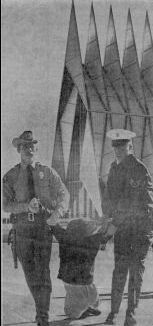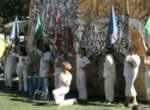|
Home
|
Terrorist’s Creed
Fanatical Violence and the Human Need for Meaning
by Roger Griffin
Professor in Modern History, Oxford Brookes University
Griffin is interviewd by Wired:
How Studying Extremist Psychology Can Help Prevent Another Bombing
BY ROBERT BECKHUSEN - 04.22.13
One prominent expert on extremism and radicalization thinks the crucial step for detecting and stopping the next would-be bomber is to bone up on psychology.
Not even the FBI ultimately suspected accused bombers Tamerlan and Dzhokhar Tsarnaev were about to plant deadly bombs that killed three and wounded about 180 last week. Extremist violence can be like that. “Because their outward behavior was so normal,” Roger Griffin, a professor of political science at Oxford-Brookes University tells Danger Room, “they weren’t picked up as a threat.”
Griffin would know. Having built a career studying far-right extremism, Griffin shifted to studying domestic radicalization — including advising the British Home Office — after the “7/7″ bombings in London by a group of domestic terrorists in July 2005. He believes violent extremism of any variety should be understood less as a political phenomenon than as a psychological state — particularly, as a form of destructive and self-destructive behavior that’s rooted in feeling disconnected from the modern world.
Read More Here
|



|
Rethinking What We Read in the Newspapers About Terrorism
From a chapter in Griffin's book, with the author's permission
At https://buy-essays-now.com/ all of the chapters are free for readers to look through.
|
The widespread misunderstandings of the metapolitical causes of terrorism, and the role that religion, particularly Islamism, may play in them has had important consequences for its coverage in the media.
The Washington Post of 27 January 2012 reported the case of Yonathan Melaku, a US citizen of Ethiopian ackground raised by Coptic Christian parents. The former Marine was arrested while on his way to desecrate the graves of US soldiers by scrawling ‘Arabic statements on them’ and leaving ‘handfuls of explosive material nearby as a message’.
23 Months earlier he had gone on:
...a mysterious shooting spree that targeted the Pentagon, the National Museum of the Marine Corps and two other military buildings in Northern Virginia. A video found after Melaku’s arrest showed him wearing a black mask and shooting a 9mm handgun out of his Acura’s passenger window as he drove along Interstate 95, shouting ‘Allahu Akbar!’
The article indicates that Melaku was a recent convert to Islam and had decided to carry out a series of attacks on buildings and ‘sacred sites’ of the US military, the synecdoche of the nation that Islamists see as the imperialist arch-enemy of their faith. Despite these clues, the article’s headline reads
‘Motive of Shooter who Targeted Military Sites is Unclear’.
The fact that over a decade after 9/11 a patently obvious Islamist message did not get through to the journalists of the Washington Post suggests continuing failure to appreciate the semiotic dimension of what took place that day in the capital of the US.
= = =
Roger Griffin. 2012.
Terrorist's creed:
fanatical violence and the human need for meaning.
Basingstoke: Palgrave Macmillan.
Copyright 2012, Palgrave Macmillan.
|
|
| |
1 Forethoughts: The Liquid Fear of Terrorism 1
Apocalypse in the subway 1
The Titanic syndrome 4
Liquid meanings: The need for definition 9
The place of this book within terrorism studies 12
The terrorist’s creed 15
The book’s structure 17
2 Terrorism as Zealotry: Defending the Nomos 24
The human need for a ‘sacred canopy’ 24
Defending a beleaguered tradition: The Zealotic response 30
Zealotic terrorism in the ancient world: The Sicarii 34
The Assassins’ defence of their nomos 37
Chechen terrorists as modern Zealots 39
The Tamil Tigers’ defence of their sacred canopy 43
3 Modernist Terrorism: Creating the Nomos 47
The dynamics of cultural renewal 47
Modernism as a revolt against anomy 51
Terrorism as a form of programmatic modernism 54
The modernist dynamic in Russian nihilism 56
The active nihilism of God’s orphans 59
Fin-de-siècle anarchism and ‘modernism of the deed’ 63
4 The Metapolitics of Terrorism in Fiction 67
Fyodor Dostoevsky: The terrorist as ‘devil’ 67
Building towers and destroying towers 70
Joseph Conrad: The terrorist as ‘propagandist of the deed’ 74
André Malraux: The terrorist as existentialist 78
Tom Robbins: The terrorist as anarchic individualist 80
Sunjeev Sahota: The terrorist as Zealotic orphan 83
5 The Metapolitics of Terrorist Radicalization 88
Terrorist radicalization Stage One: Nomic crisis 88
Stage Two: Splitting and the Manichaean world-view 92
Heroic doubling 95
The Alice Syndrome 99
Stage Three: The bliss of completion 101
Two Hollywood takes on the metapolitics of radicalization 103
Terrorism’s pyrrhic victory 108
|
6 Modern Zealots of the Sacred Homeland 111
The modernization of Zealotry 111
Religious fundamentalism again 113
Chechen rebels and Tamil Tigers revisited 116
The Sikhs’ quest for Khalistan 121
Recovering the Promised Land of the Israelites 126
Inferences about Zealotic terrorism 132
7 Modernist Terrorism Red, Black, and White 137
The vitality of terrorism before 9/11 137
The radicalization of an ‘in-between generation’ 139
The post-nihilism of the Baader–Meinhof Gang 141
The holy warriors of the Kali Yuga 145
Timothy McVeigh strikes back against ZOG 149
The cleansing power of blood 156
8 The Hybrid Metapolitics of Religious Terrorism 158
The intricacies of ‘religious terrorism’ 158
Defining religious terrorism 160
The secular dimension of some ‘religious conflicts’ 161
The temporal immortality of ‘the inner thing’ 163
‘Cosmic truth’ in an ocean of anomy 166
From fantasy war to act of religious terrorism 170
9 Islamism’s Global War against Nomocide 173
The elusive nature of political Islam 173
Six Islamic reactions to the threat of nomocide 176
Maududi, Qutb, and the first wave of Islamism 180
The ‘second wave’: Statist Islamism 184
Renomizing the world through terror 186
Islamism as a ‘mazeway resynthesis’ 189
10 Afterthoughts on the Nature of Terrorism 195
Rethinking the dynamics of terrorism 195
Rethinking the role of the sacred in terrorism 198
Rethinking ‘religious’ and ‘secular’ terrorism 201
Rethinking what we read in the newspapers about terrorism 206
Rethinking terrorism’s impact on the social imaginary 212
Rethinking the de-radicalization of potential terrorists 217
|
|
|
Featured Social Movement Organization
Spirit House Project uses the arts, research, education, action, and spirituality to bring diverse peoples together to work for racial, economic, and social justice, as well as for spiritual maturity.
Featured Physical Archives
Marquette University has acquired a large collection of FBI files on US right-wing organizations and individuals. The files were released under the federal Freedom of Information Act to researcher Ernie Lazar. The Lazar Collection is also ONLINE!
Emory University: Neighbor's Network (Atlanta, Ga.) 1987-1998)
Featured Multimedia Anti-Nazi lithograph cartoons by a survivor of the the genocide.
Why this Webpage? The goal of the website is to provide online linkages to a variety of existing and new transatlantic resources for the study of social movements that seek to expand or restrict access to full democratic human rights for all people. The mission is to illuminate the relationship of hierarchies of race, gender, and class to societal conflicts, especially those involving social movement organizations and their specific ideologies, frames, and narratives.
|









